what is the proper way to write a letter
While email and texts have get the standard form of written communication in today's fast-paced, digital world, in that location'south still a place for old-fashioned, snail mail letters.
The physical heft of a letter gives the advice a psychological weight that e-mail and texts just don't have. Digital communication is ethereal and ephemeral, and consequently lends itself to impulsive and flippant transmissions. A letter, on the other hand, is tangible evidence that someone has put some idea into their writing. They've outlined, edited, and stuck to a structured concern form in the missive's creation. To send that letter of the alphabet, its author had to take the time to get an envelope and a postage. They then had to check that the address was written correctly to ensure its safety arrival. In curt, a concrete letter shows that someone took the time to give a damn. And that's difficult for the recipient to ignore.
Desire to cut through the countless piles of applications employers get? Instead of submitting even so some other resume through the online mill, transport yours through the mail.
Want to allow your elected representative know your views on an issue? Instead of signing a cookie cutter petition, write them a letter.
Want to show a friend you've really been thinking about them? Instead of sending a lousy, "What's been going on?" text, write them a note.
Whenever you want to ensure that your message is taken seriously, choose the ponderance of a physical letter over the flimsiness of digital communications.
Only what if yous've never written a letter? Commencement, don't experience bad. If yous grew up in a time when the internet had e'er existed, mayhap you've simply never thought about writing ane. Simply why not give information technology a endeavor? By the time y'all're finished with this commodity, you'll exist ready to write your very first.
The 2 Types of Messages: Formal and Informal
There are two types of messages: formal and informal.
Formal letters have sure formats and protocols you should follow and are used when yous're communicating with businesses, government officials, or individuals you lot don't know very well.
Breezy letters have fewer rules and are used when you're writing close family and friends.
Formal letters have more than rules regarding structure and protocol, so let'due south look at that type first.
How to Write a Formal Letter of the alphabet
one. Formal Letters Should Be Typed
While nil looks handsomer than a letter written with spectacular penmanship, handwritten messages are also personal (and possibly messy) for formal situations. Since formal letters are used when business is discussed, you want to make sure your writing is legible and professional. Relieve your handwritten letters for when you write your grandma or best gal; type your alphabetic character if y'all're writing a congressman or potential employer.
two. What Blazon of Paper to Use
For most formal letters, feel costless to employ standard white printer paper. If you want to add together a scrap of brio to your communication, bandy it out for some prissy cream colored resume paper. It has more of a fabric experience and hearkens back to an aloof time when people wrote on sheepskin.
In the United States, standard paper size is 8.five″ x 11″. In other countries, information technology'southward labeled as "A4."
three. Choose the Right Font
A formal alphabetic character isn't a time for you to bear witness your zany, creative side. No comic sans (does anyone ever use comic sans?). Go on it strictly concern.
For printed letters, fonts with serifs are your all-time bet. They just look sharp and they're easy to read on newspaper. Fonts without serifs give your writing a fleck of airiness and informality. For formal letters, you can't go incorrect with Times New Roman or Georgia.
4. Choose Your Form: Block or Indented
Formal messages follow, well, a course. The purpose of this form is to make the letter easy to read and to direct the reader as to where to look for important information.
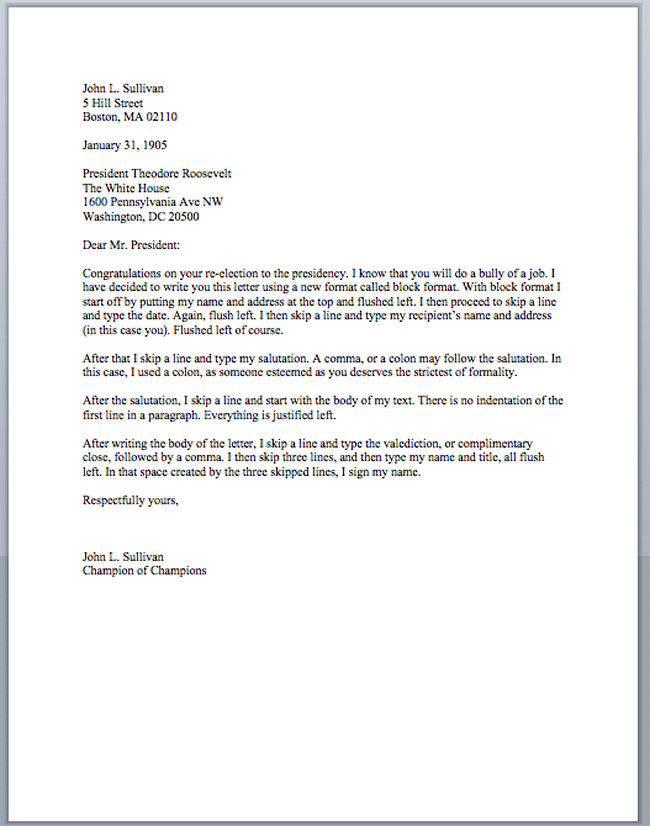
With cake form, all of your text is typed flush left with 1-inch margins all around.
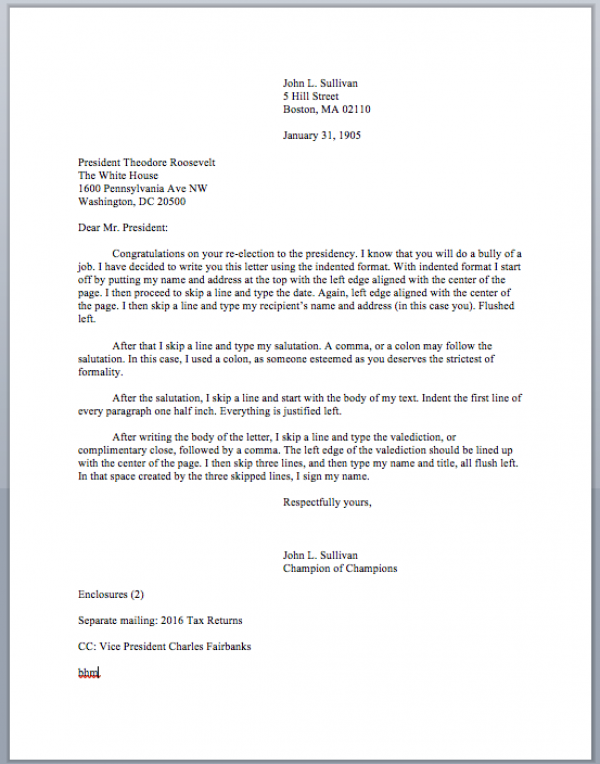
With indented form, you indent the get-go line of a paragraph one inch. You also put your accost and date and so that information technology's correct justified. We'll show you what that means here in a bit. Indented form was the manner nigh people wrote business organisation messages before the proliferation of PCs.
Block form is the easiest to format and the easiest to read. Indented format adds a bit of visual interest and old-schoolhouse flair. Either is acceptable for formal messages.
5. Type Your Address and Today's Date
The first information you put on a formal alphabetic character is your proper noun and address. Then skip a line and type the appointment that yous're writing the alphabetic character.
If you're using block grade, this will exist typed at the top, left justified. It will await like this:

If you lot're using indented class, place your address at the meridian, with the left edge of the accost aligned with the eye of the page, like so:

If you're typing your letter of the alphabet on letterhead with your proper noun and address, yous practise not need to type out your name and address. Just the date volition practice.
six. Type the Recipient's Accost
Afterwards the engagement, skip a line and blazon the name and address of the recipient, left justified for both cake and indented form. If the letter is going to the company where the recipient works, the name of the recipient goes first, followed by the name of the visitor.
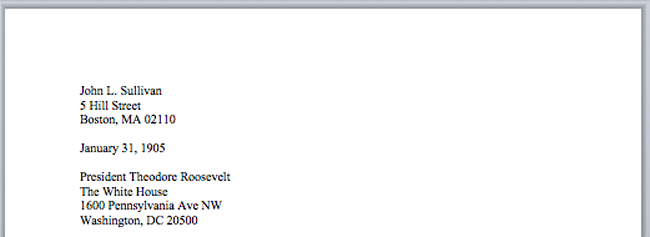
Block course
When typing the recipient's proper noun, use their total proper name, including title. If she's a doctor, it's "Dr. Laura Duncan." If he's a state representative, it's "Rep. Mike Walls." Professor? "Prof. Fears." You get the idea.
seven. Type the Salutation
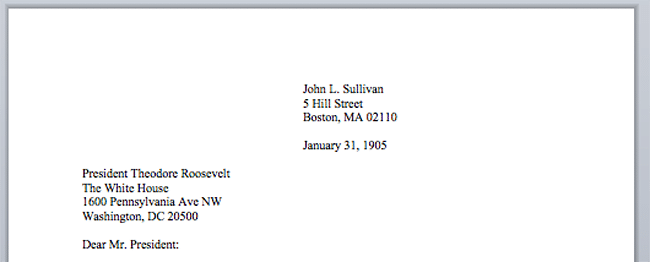
Indented form
Skip a line and type your salutation. Yous can't become wrong with "Honey [Name of recipient],". If you know the recipient well, go ahead and utilise their first name. If you don't know them well or the relationship is formal, use their championship and last name, east.thou., "Dear Mr. Ferguson," "Love Prof. Slater," etc. Make sure you spell the recipient's proper noun right!
If you're writing a alphabetic character that's non directed to anyone in particular in the organization, get with "To Whom It May Concern,". Ideally, before you lot write a letter of the alphabet, you'll practice your enquiry so that it'due south directed to someone specific. Use "To Whom It May Business organisation," only after you've diligently looked into whom to accost and ascertained that a specific name isn't available.
With the salutation in formal letters, y'all can follow the proper noun with either a comma or colon. Dorsum in the day, information technology used to be strictly colon as it connotes more formality than a soft, breezy comma. Most business etiquette folks agree that commas are fine today. If you lot want to add some military seriousness to your alphabetic character, get with the colon.
eight. Type the Body
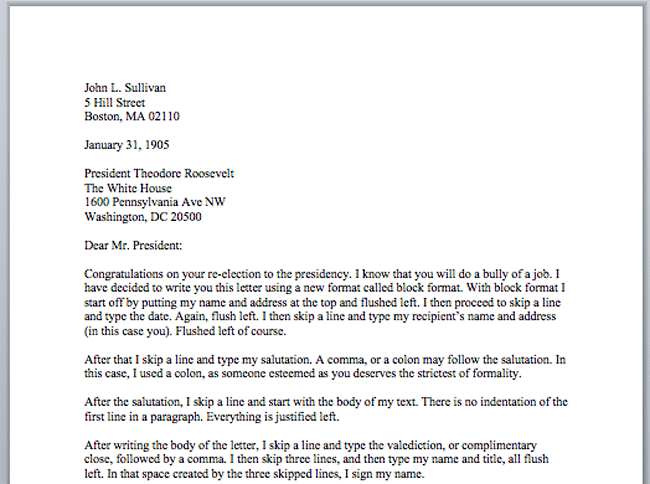
For block forms, unmarried infinite and left justify each paragraph inside the trunk of the letter. Go out a blank line between each paragraph.
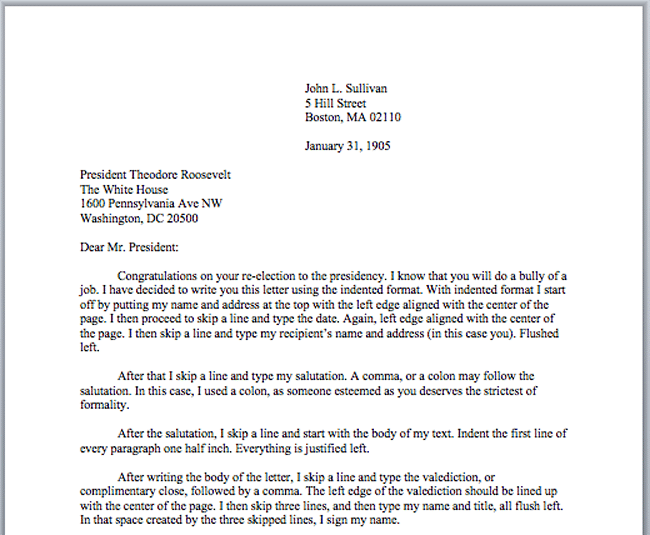
For indented forms, unmarried space and indent the kickoff line of each paragraph 1 inch. Leave a blank line between each paragraph.
With formal letters, keep it concise and to the point. A formal letter should not be more than one page, unless absolutely necessary.
Use the first paragraph for a short pleasantry— "I hope you lot're well." — and and so become right to the indicate — "I'g writing in regards to…".
Use the residuum of the letter to justify the importance of your main point, by providing background info and supporting details. Use bold, crisp language. Avoid passive voice when possible.
The closing paragraph should recapitulate the purpose of the letter and, in some cases, request some type of activeness or follow up. If you have a question or request, make answering or fulfilling it as specific and turnkey as possible. Don't be vague! Ask something the recipient tin can say yes or no to, or that makes information technology easy for them to direct you to the proper resource. Your recipient is likely a busy person, and the easier yous brand it for them to reply your alphabetic character, the more likely you lot'll be to get a response.
Stop with some other pleasantry such as "I expect forwards to talking to you lot soon" or "Delight don't hesitate to achieve me by phone if you lot'd like to hash out in particular." In many cases, information technology's advisable, and polite, to add together: "Thank you for the time and consideration."
9. Type the Valediction
Later your endmost paragraph, skip two lines and put your valediction — too known as the "complimentary close."
If you're writing someone you don't know well or accept a formal relationship with, y'all can't get wrong with choosing "Sincerely" for your valediction. Something like "Yours Truly" can as well piece of work if "Sincerely" doesn't seem to have the right feel.
If you lot have a closer human relationship, feel free to use more than informal closings like "Warm(est) regards," "Kind(est) regards," "Best wishes," or simply "All-time."

Block form
On block formats, the complimentary shut is positioned flush left; on indented form letters, the complimentary close starts in the centre, flush with your accost and date.
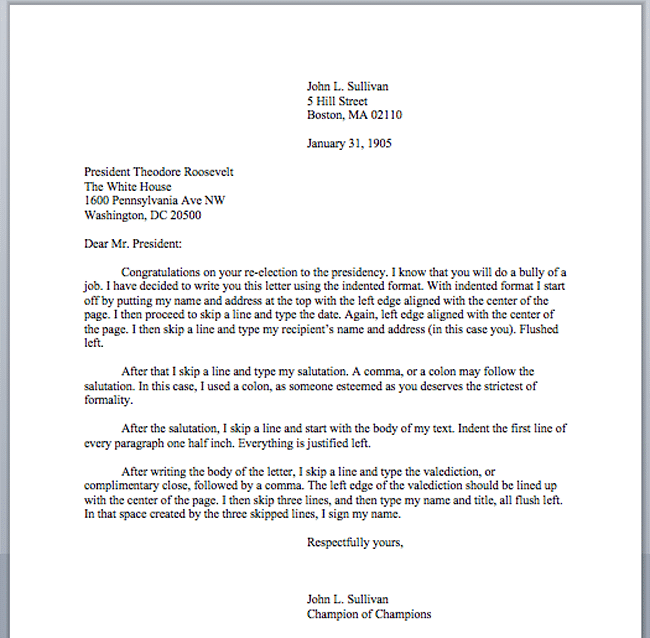
Indented class
After the gratis close, skip three lines and type your full name. Feel complimentary to include any credentials here similar CPA, Ph.D., or Esq.
Sign your handwritten name between the valediction and your typed proper noun.
10. Additional Info

Enclosures. If you're enclosing boosted items with your letter (like a resume), skip one line beneath your signature block and type "Enclosures," or "Encl." You can likewise indicate the number of additional documents by putting the number in parentheses. So if you had ii enclosures you'd type "Enclosures (2)."
Separate Mailing. If you're sending an additional document that's non in this mailing, indicate with "Separate Mailing," or "Under Separate Cover," followed by the proper noun of the piece. For example, "Split Mailing: May TPS Report."
You'd put this 1 skipped line below the signature block.
Courtesy Copies. If you're sending this same alphabetic character to other people, allow the recipient know with "CC:" or "Copies to:" followed by the names of the other recipients. List the names in alphabetical order past terminal name. This would go 1 skipped line beneath the signature block or one skipped line below your enclosure or separate mailing notation.
Typist's Initials. If someone else has typed the letter out while you lot dictated, accept them include their initials in lower case letters two lines beneath the signature cake. If yous accept enclosures or separate mailings, put it one skipped line beneath those.
11. How to Fold Your Formal Letter
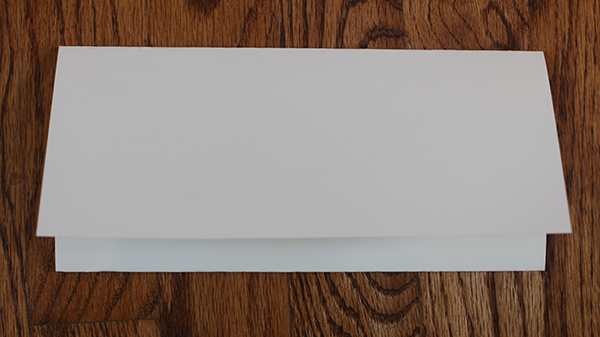
If you're putting your letter in a standard sized mailing envelope, fold information technology into thirds using the "C-Fold." Bring the bottom of the canvas up so that it'due south two-thirds of the way upwards the page, and crease. So fold down the elevation portion so that the crease matches upward with the bottom of the paper.
How to Write an Informal Letter of the alphabet
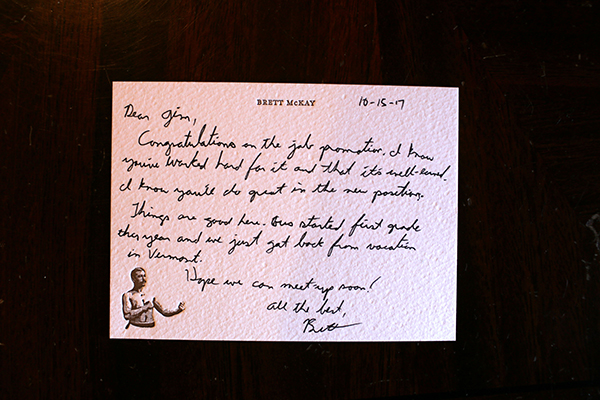
Informal letters are for friends, family members, or other associates with whom you lot have a shut relationship, and unlike formal letters, they don't have a strict form or protocol.
Feel free to handwrite your informal letters. In fact, we'd encourage y'all to do so equally it adds some character and personality to your letter. Your handwriting is unique. Reading someone'southward handwriting brings their personality and presence to the recipient — it feels like a office of the person is in that location, even if they're actually hundreds or thousands of miles abroad.
You tin use whatsoever type of paper you lot want — notebook paper, copy paper, etc. I've found writing with nice jotter makes the writing feel more than enjoyable. (If yous're in demand of some masculine stationery, bank check out our option in the AoM Store.)
No need to put your or your recipient'due south address at the pinnacle. Just a appointment in the upper right paw corner.
For the salutation, "Dear [recipient's first name]," is fine. Yous tin can too omit the "Dear," and just write their showtime name. You tin even utilise an endearing nickname like "Knucklehead" or "Goomba-head."
No protocols on the formatting of body paragraphs. Feel complimentary to use cake or indented. And be as lucid or curtailed with your writing equally you want.
What should yous write in your breezy letters? For a general letter of correspondence, you should share what's been going on in your life, enquire what'southward been going on in the recipient'due south, and respond to any questions they asked you in their terminal letter of the alphabet.
Of course, at that place are besides personal letters written for diverse specific purposes (notes of gratitude, congratulations, condolence, etc.). For insights on the types of letters you can pen, read our commodity on the seven letters everyone should write before they're lxx.
Shut with whatsoever valediction yous similar: "Best regards," "All the best," "Cordially," "Love," "Gratefully" (if information technology's a thank you note), etc.
How to Accost an Envelope
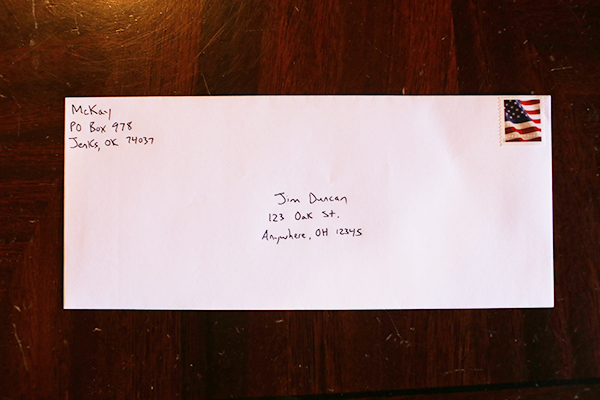
Beginning rule of addressing an envelope: Write legibly! Naturally, if you lot don't write the recipient's address legibly, the postal service won't be able to deliver information technology to their domicile or business. And if you don't write your render accost legibly, so fifty-fifty if they exercise go your letter, they won't be able to write you back!
This sounds very basic, but I can't count the number of times I haven't been able to respond to a reader's letter because I can't read their return address which they rendered in a chicken scratch scrawl. You lot may be tempted to do this step speedily and sloppily considering you know your address so well; merely remember that the recipient has never seen your address and has to be able to copy it accurately in order to send a answer you'll actually receive.
So, if you're hand addressing your envelope, practise then legibly! (This is doubly true if you're sending postal service internationally, as the recipient may non exist familiar with the address format or the language of your street/town.)
The recipient'south accost goes in the middle of the envelope in this format:
Name
Street Address
Floor Number, Apt. Number, Unit of measurement Number, Etc.
Metropolis, Country Zip Code
State
For international addresses it's going to exist different. The format varies between countries and even within a single country. It can be confusing. Whether you're an American sending mail abroad, or an international sending mail to usa, the Usa Postal service recommends using this format.
Your accost (the return address) goes in the upper lefthand corner. Write your name and accost in the upper lefthand corner and then the mail service office knows where to return the letter in case it's undeliverable. The return address is also of import for breezy messages where you haven't written your address in the letter itself. This is what your recipient will utilize to write you dorsum.
And make sure it goes in the lefthand corner. I get letters from people who write the return address on the back of the envelope, along the seam of its closure. When I open upwardly the letter of the alphabet, I end upward trigger-happy through the address and have to slice it back together to try to figure out where to ship my response (aye, I could get a letter opener, only I prefer to open envelopes with my manly paws).
There you go. How to write a letter of the alphabet. Information technology's a lost art, but one worth preserving.
Tags: Writing
Previous Next
warnerbradoet1971.blogspot.com
Source: https://www.artofmanliness.com/skills/how-to/how-to-write-a-letter/
0 Response to "what is the proper way to write a letter"
Post a Comment